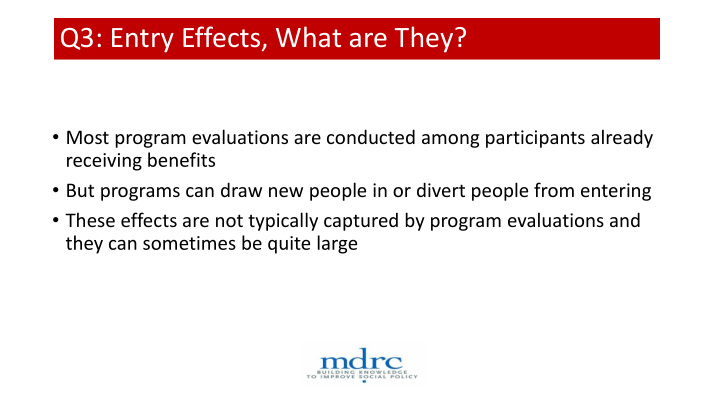



Q3: Entry Effects, What are They? • Most program evaluations are conducted among participants already receiving benefits • But programs can draw new people in or divert people from entering • These effects are not typically captured by program evaluations and they can sometimes be quite large
Q3: Why Are There Entry Effects? • Deterrence: Applications reduced to avoid hassle, mandates, sanctions, work requirements etc. • Induced entry: Increased entry in order to take advantage of financial supplements, free employment training, other beneficial services. • Can vary based on prevailing wages, economy, perceptions, stigma, time frame. • The SNAP demos can have either positive or negative entry effects depending on what is tested.
Q3: Entry Effects, The TANF experience Excerpted from “Evaluating Welfare Reform in the United States” by Rebecca Blank.
Q3: Entry Effects, Most WTW Studies Underestimated Reductions in Welfare Bloom et al. , 2000. Family Transition Program: Final Report on Florida’s Time Limited Welfare Program
Q3: Entry Effects, Measurement Strategies • Hard to measure well. • Most commonly: microsimulations (Moffitt), caseload/panel data analysis: PSID etc. • Can be done experimentally: • SSP entry effect demonstration (detected small, positive entry effects into a wage supplement program). Randomize new applicants before the intervention and see if there is delayed or expedited exit in response to the onset of the intervention (Card, Robins & Lin, 1997) • Nested designs: Do Mandates Matter (Nov, 2000)
Q6: Outcomes, General points • Need to think hard about program theory/logic model and program goals. • Think through the sequence of activities and the time to outcome. • Measure mediators and outcomes. • Limit outcomes to manage multiple comparison bias. • Pre- specify and tier outcomes into “primary,” “secondary” categories.
Q6: Outcomes, Establish Treatment Contrast • Many tests are undermined by weak differentials (e.g. due to heavily served control groups or low take-up among the program group). • Measure participation in services. Depends on intervention, but generally things like… • Pre-employment services (e.g. resume prep, soft skills) • Employment and training • Job search/placement • Supportive services • To assure a good test: Measure these kinds of factors early to enable corrections/technical assistance/adjustments in design.
Q6: Outcomes, Typical Outcomes • Food security • Employment • Overall well being (physical/mental) • Employment retention • Assets/debt/material hardship • Earnings, wages, hours, weeks • Social networks/peer effects • Benefits, job quality etc. • Child outcomes • Income (individual and hh) • Accuracy of benefit payments (QC • TANF and SNAP benefits issues increase w/employment • Health insurance transitions) • EITC • Household composition
Questions? Richard Hendra, Ph.D. Richard.Hendra@mdrc.org
Recommend
More recommend